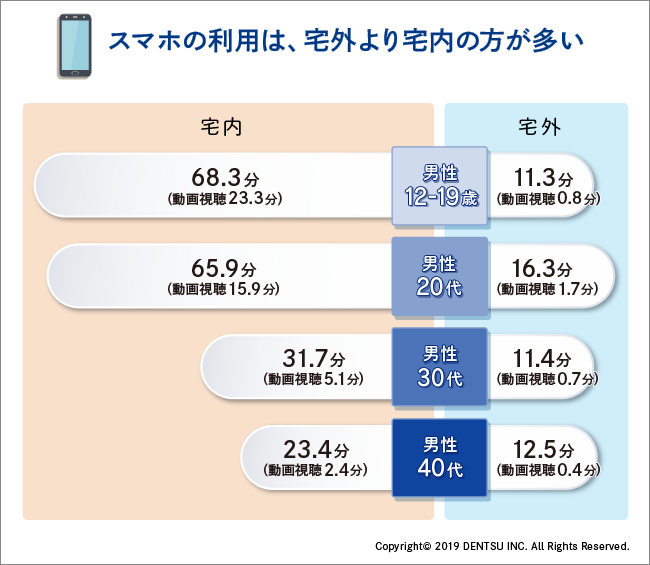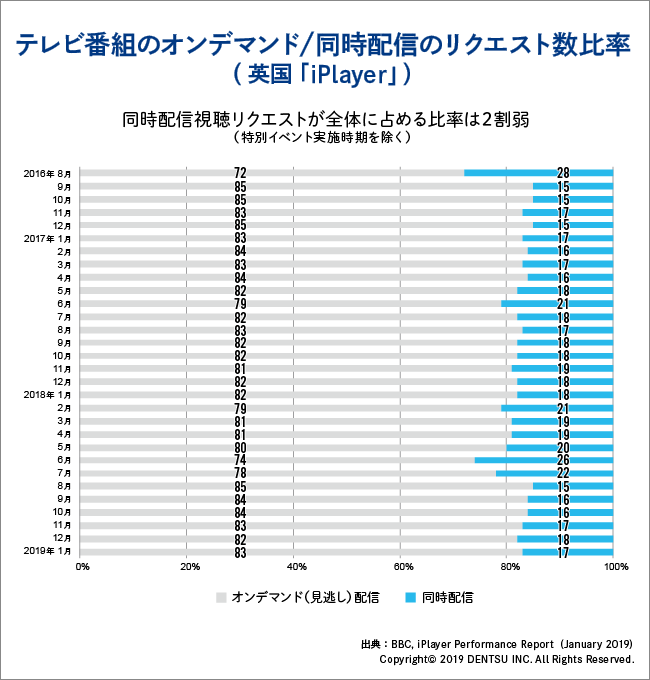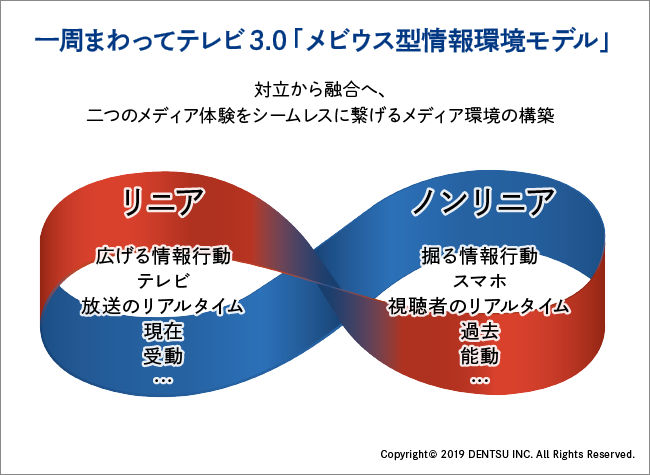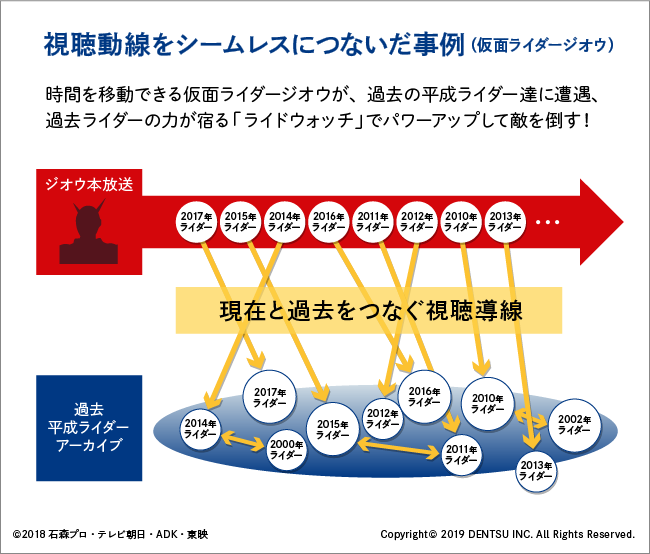In light of the growing number of people watching videos on TV, the author proposed the concept of "Back to TV" in 2017. It was a suggestion to refocus on the importance of television precisely because smartphones and tablets had become so widespread. ( Back to TV )
Subsequently, in 2018, we examined methods to maintain and expand television broadcasting's reach by communicating the excellence of television broadcasting as a system, framing this as "Back to TV 2.0." ( Back to TV 2.0 )
In this series so far, we have analyzed consumers' viewing behaviors within their homes based on joint research by Video Research Ltd. and Dentsu Inc. Building on this, we will examine how to design consumers' viewing environments going forward and propose a new design concept called "Back to TV 3.0." Note that "TV" in this article refers to the television set itself, not the content being viewed.
From a device solely for watching broadcast television,
to becoming one of many screens
As mentioned in the first installment, the premise of this series is the fact that "smartphone usage is actually higher indoors than outdoors." This ratio tilts even more toward indoor viewing for video content, with the trend being more pronounced among younger demographics.

Time spent using smartphones for internet, SNS, video, and email aggregated. Created by Dentsu Inc. Media Innovation Lab from Video Research Ltd. MCR/ex data (first half of 2018, Tokyo area).
Many people likely perceive in-home viewing behavior as "TV = passive viewing" and "smartphone = active viewing." TV has traditionally been seen as a device for passively watching live broadcasts following a scheduled timetable centered on terrestrial broadcasts, while smartphones were viewed as devices for actively searching for and watching videos of interest.
However, this survey revealed situations that cannot be explained by such a dichotomous view. When viewers have a block of free time after returning home, they binge-watch VOD on TV; when they don't, they watch terrestrial broadcasts live. Alternatively, they might watch the previous week's episode on their smartphone via catch-up streaming and then watch the subsequent episode on TV. This confirms that viewers actually choose services based on their disposable time (time they can freely use at their own discretion).
In other words, viewers switch devices based on their situation. They are largely unaware of whether a program (content) is delivered via broadcast waves or the internet. They simply don't care about the transmission route differences that broadcasters and rights holders fret over.
During the era dubbed "convergence and collaboration between broadcasting and communications," a broadcast augmentation system model became popular, treating the TV as the main screen and smartphones or PCs as secondary screens.
The images displayed on TV remained traditional services delivered via broadcast waves. TV broadcasts served as triggers to introduce program and commercial details/related information to smartphones or PCs via the internet. Designing this "broadcast + alpha model" was considered a next-generation approach that could be implemented without impacting existing business models.
However, it's crucial to note that approximately 30% of the main living room televisions—long viewed by broadcasters as "screens for watching TV broadcasts"—are now being connected to the internet (*). Beyond viewing terrestrial, BS, CS, 4K8K broadcasts, these devices are increasingly being used to access video streaming services.
Dentsu Inc. Media Innovation Lab's proprietary research also confirms that users who can watch video streaming services on their TV tend to spend more time watching TV compared to those who cannot.
Given this situation, it is clear that televisions are transforming from dedicated devices for watching broadcast television into screens that can also enjoy online video streaming services. The television is now just one of many screens.
*According to Dentsu Inc.'s "d-campX Survey" (1st half of 2018 / 7 regions combined), 32.7%.
It is necessary to provide content seamlessly
Seamless content delivery is essential
Figure 1, the "Mobius Information Structure Model," visually represents the media consumption structure discussed in this series. A Mobius strip is formed by twisting a strip of material once and joining its ends, creating a continuous surface with no distinction between front and back.
Figure 1
Regarding users' motivations for video viewing, the figure depicts how "casual browsing (spreading)" and "targeted searching (digging)"—like a Möbius strip—do not have a fixed "front" or "back." Instead, they instantly flip depending on the viewer's context (TPO) and motivation.
For example,
・Linear services (e.g., TV broadcasts where content is viewed following a predetermined schedule) and non-linear services (e.g., VOD [Video on Demand] where content is delivered based on viewer demand)
・"Broadcasts" viewed on TV versus "online video streaming"
・"TV devices" versus "personal devices"
・"Broadcast real-time" versus "viewer-perceived real-time"
・"Passive viewing" and "Active viewing"
・"Present" and "Past"
These various "fronts" and "backs" coexist and repeatedly invert.
Given that screens are intuitively and experientially selected based on the viewer's interest vector (broadening/delving), providing seamless viewing pathways between "front" and "back" to enable content delivery aligned with the viewer's timeline is a critical challenge for broadcasters and streaming services.
Here, we present "Kamen Rider Zi-O & the Heisei Kamen Rider Series" as an example of designing a smooth pathway between "present and past."
"Kamen Rider Zi-O" airs on Sunday mornings on the TV Asahi network. The Heisei Kamen Rider series marked its 20th anniversary in 2019, with Zi-O being the 20th installment.
The show's premise involves the protagonist, Zi-O, who possesses the ability to travel through time. He encounters past Kamen Riders and combines his Ride Watch with theirs, enabling him to utilize the powers of all the Heisei-era Riders.
Furthermore, in 2018, coinciding with the release of the movie "Kamen Rider Heisei Generations FOREVER" (which also features Zi-O), Toei temporarily made the first and second episodes of every past Heisei Rider series available for free on YouTube.
Children watching YouTube were unaware of when these shows originally aired, effectively reviving the entire past catalog as "current works." To watch episodes beyond the first two, viewers had to subscribe to Toei Channel's paid service. Overall, this constituted an exceptionally well-executed window strategy.
Even more noteworthy is the merchandising strategy. In children's toy sections, figures and Ride Watches from all past series were displayed not as merchandise for older shows, but as products for the latest series. This approach eliminated the concept of "past works" for both the shows and their related goods.
By synchronizing TV broadcasts, online streaming, and merchandising, an ideal holistic design was achieved. There is much to learn from this case study.
By considering viewing paths aligned with the timeline,
and a service that provides both broadcast and streaming through a single portal is essential.
Applying what we've discussed to the challenges faced by broadcasters reveals important insights.
First, there is the benefit of seamlessly connecting the present and past along the timeline. For current television operations, the ideal would be to build an integrated service where viewers can freely navigate between terrestrial broadcasts (live) and online catch-up for one week or VOD archives, all through a single portal.
For reference, let's examine data from the BBC's internet TV and radio service, iPlayer.
The usage ratio (request-based) between simultaneous streaming (live) and catch-up on iPlayer is roughly 2:8, excluding special periods like the Rio Olympics, FIFA World Cup, or general elections. Catch-up viewing significantly outpaces simultaneous streaming (live).

*Special event periods: August 2016: Rio Olympics; June 2017: UK General Election, One Love Manchester; June-July 2018: FIFA World Cup (Russia).
Some interpret this ratio as indicating low demand for live streaming, suggesting the business model is unsustainable. I disagree. We should interpret it as: "The viewing motivation ultimately lies in the live stream, and that viewing triggers users to flow into time-shifted viewing."
In this case, live streaming becomes the "front," while the "back" (catch-up) serves as the viewing pathway motivation. Viewers start thinking: "There's nothing else I want to watch live right now. I want to see last week's episode of the show I just watched. Come to think of it, maybe I'll watch that show that aired last weekend?" At that moment, having a clear viewing pathway to the "back" catch-up service is crucial.
Paradoxically, it's precisely because iPlayer integrates simultaneous streaming and catch-up services within a single portal that such a high request ratio occurs for catch-up.
Beyond the viewing path along the time axis (vertical relationship), attention must also be paid to other programs available for viewing at the same time—the "horizontal relationship."
The "horizontal relationship" is a fiercely competitive arena. For commercial broadcasters, where ratings are a key metric, increasing their own program ratings requires capturing viewers watching other networks' programs, given that HUT (Hours Under Television) remains constant.
However, due to drastic changes in viewing environments, programs competing horizontally are no longer limited to rival networks' head-to-head offerings. Viewers may switch to online video streaming services, or engage in timeshifted viewing or catch-up viewing of their own network's content.
The crucial point here is whether there exists a "viewer return pathway" for those who have switched to other options.
Traditional television featured NHK and commercial broadcasters (BS/CS) coexisting as a single portal service, allowing viewers to freely switch channels based on their preferences. I believe this element should also be realized in internet-based services. Implementing a Möbius-type information structure model here is the shortest path to expanding television's power.
Beyond vertical relationships, we need horizontal ones: all broadcasters viewable in that area should offer their services—live broadcasts, simultaneous streaming, and catch-up archives—through a single portal. Building a system where viewers can freely navigate within this space would enhance convenience. This, in turn, could bring us closer to an ideal model that meets advertisers' expectations, including those of the advertising model.








